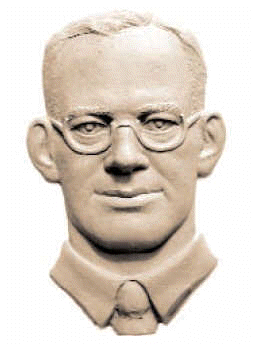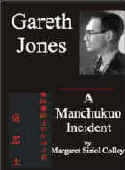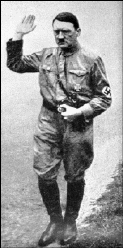Gareth Jones
[bas relief by Oleh Lesiuk]
HOME |
Stop Press |
Complete Soviet Articles & Background Information |
Précis of Gareth's
|
All Published Articles |
BOOKS
|
|
|
|
More Than Grain of Truth(2005) |
|
|
TOPICAL
'Are you Listening NYT?' U.N. Speech - Nov 2009 |
Gareth Recognised at Cambridge - Nov 2009 |
Reporter and the Genocide - Rome, March 2009 |
Order of Freedom Award -Nov 2008 |
Premiere of 'The Living' Documentary Kyiv - Nov 2008 |
Gareth Jones 'Famine' Diaries - Chicago 2008 |
Aberystwyth Memorial Plaque 2006 |
GENERAL
Scholarship Fund |
Site Map |
Links |
Legal Notices |
Sponsored Links |
Contact |
THE WESTERN MAIL
AND SOUTH WALES NEWS, February 22nd, 1933
A WELSHMAN LOOKS AT EUROPE (ix)
STORM OVER THE POLISH CORRIDOR
By GARETH JONES
(NOTE. Mr.
Gareth Jones travelled from Dresden via Berlin, and across, a part of Poland, to
the Free State of Danzig, where he interviewed the leading authorities. He
now describes his return journey to Berlin.) IN THE AEROPLANE FLYING FROM
DANZIG TO BERLIN.
At last we are
off. After rushing across the aerodrome field, and then bumping slightly,
the aeroplane has left the ground, and beneath us we see the fields, roads
houses, shores, and woods of one of the most fateful regions in all
Europe. The aeroplane is
beginning to rock. Each time the pilot tries to rise one wing goes up and
the other down. I stand up to take my overcoat off and am tossed into my
seat again. No wonder the
aeroplane is two hours late. A strong wind was blowing when Professor
Haferkorn, who was once lecturer at Aberystwyth College and mastered Welsh,
brought me to the airport nearly three hours ago. We waited in the
restaurant, which had many pictures of Bismarck. I went to buy my ticket
and found that my name was written on it as “Professor de Jong.” I was fated to
remain in the Free State of Danzig, which was torn away from Germany by the
Treaty of Versailles, more hours than I expected, for a messenger entered and
announced: “Ladies and
gentleman. Due to the very strong wind, the aeroplane had to turn back,
but is now on its way, and will be two hours late.” Historic Line
The whirr of the
engine was at last heard. We went out and saw the machine, on which was
written: MOSCOW-BERLIN. The words made one feel that one was really in
Eastern Europe and going to fly along part of the historic line Moscow-Berlin,
which connects Asia with Europe, with Communism, Capitalism, and the land of
entrenched proletarian dictatorship with that of growing Fascism. The Moscow-Berlin
plane is now rocking over the Baltic coast. The Baltic is looking bright
blue, although from the west black storm-clouds come. If I look around I
can see the city of Danzig, which is about as large as Cardiff. A small steamier
is entering Danzig harbour, about which diplomats have been fighting since
1919. That streak is the Vistula. Now exactly underneath is the
Monte Carlo of the North, Zoppot. The casino and the pier can be clearly
seen. Near the sea one has a glimpse of the two prewar villas of the Crown
Prince, and one recalls that he was most popular with be Danzigers. The Corridor
It is getting
difficult to write, for the wind seems to be growing stronger. Underneath
is the railway which links Danzig with the Fatherland. We are now flying
over woods. The plane has several times dropped suddenly and then
rocked. A little snow remains on the round. We are leaving
the Baltic-but one moment. There is a port-one only gets a slight view of
it-it does not look, a natural harbour at all. It is Gdynia, and was
recently built by Poland. Now we are flying
over the Polish Corridor. There are more woods underneath and a lake here
and there. We must have crossed the frontier between the Danzig Free State
and Poland. How that German pilot must boil with rage when be thinks that
his East Prussia is separated from the rest of Prussia by that narrow stretch of
territory belonging to Poland and extending to the sea! The land is very
flat underneath. We are flying about 1,000 to 1,500 feet high, and can see
the peasants’ huts, some with straw roofs, some with tiled roofs. Over
there is a brick factory-the only factory to be seen. The rest of the land
is farming land, with a village here and there, lakes, and many small pine
forests. Some of those villages are inhabited by a tribe called Kashubes.
So that is the Polish Corridor. Forced Down
No more blue sky
left now. The aeroplane is rattling and shaking. There are more
storm-clouds in front. I am beginning to regret the excellent meal I took
of pork cutlets and pancakes. The aeroplane has just recovered from a drop
in the worst air-pocket I have ever experienced. By a lake which
is frozen over there is some timber. It is difficult to realise that that
stretch of land which has only a few villages and woods and fields is one of the
danger spots of Europe and that millions of Germans would willingly die to win
it back. The aeroplane is tossing still more violently. This article will have to be finished elsewhere. STOLP: A SMALL TOWN IN POMERANIA.
A few hours ago I
had never heard of Stolp. But now we are forced to spend the night
here. I saw the passengers get alarmed as the wings of the aeroplane
seemed to go up still higher and down. At last we saw a town to the
north. The pilot flew for it and before long we made our forced landing
smoothly. Bulwark of Germanism
A man came
rushing up, opened the door, and said: “There’s another colossal storm
coming.” The pilot came out. “Impossible to fly further; It’s
dangerous,” he said. “We’ve taken an hour and a quarter to do 55
miles. The force of the wind against us was terrific.” Thus we find
ourselves in this typical Prussian town, which has as its hero Blücher, is
proud of its soldiers, and considers itself a bulwark of Germanism near the
Polish Corridor. To-morrow we fly
on to Berlin-when the storm has died down. One day a far more violent storm may break over the Polish Corridor. The names Danzig, Gdynia, East Prussia will be on the lips of all. When that storm
of national passions will break no one knows, but the dark clouds are rapidly
gathering. The forces making for strife in this part of Europe I shall
describe after the aeroplane has taken me across the Prussian plain and has
landed me in the Tempelhofer Aerodrome, Berlin. |
Adolf Hitler, Chancellor of Germany. |
||||||||
|
|||||||||




